See how a non-traditional workspace is changing the way a furniture dealership does business in the first of our three-part Work Design NOW research series, sponsored by Haworth.
This is the first post in a series of three reports showcasing the winners of the Work Design NOW 2014 competition, which was sponsored by Haworth. Check out the video above, then settle in to 25+ pages of images, floor plans, and inside scoop in the full case study.
Case study
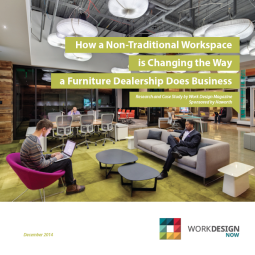 Click here to download the full PDF version of the AIREA STUDIO case study: How a Non-Traditional Workspace is Changing the Way a Furniture Dealership Does Business
Click here to download the full PDF version of the AIREA STUDIO case study: How a Non-Traditional Workspace is Changing the Way a Furniture Dealership Does Business
The case study is chock full of images, floor plans, and interviews with AIREA STUDIO‘s employees and designers, a Haworth workplace strategist, and our very own Bob Fox. The text of the case study, along with select images, is copied below.
Summary
In September 2013, AIREA Inc., a commercial furniture dealership based in Farmington Hills, Mich., opened AIREA STUDIO in the Compuware Building in downtown Detroit. The 2,500 square foot showroom, work lounge, and event space is open to the public and serves as both business development tool and product exposure incubator. AIREA designed eleven different “work-zones” in the STUDIO to reflect the variety of work styles that have emerged in today’s workplace, from a single person lounge to a forty-person conference space. Each zone is highly flexible, allowing AIREA to feature an evolving showcase of their latest products, and everyone from longtime clients to curious freelancers looking for a place to touchdown can use the space. AIREA also rents the space to groups of up to 150 people for private events.
In the first year that the STUDIO has been open, the space has:
-
Drawn over 4,000 people in to experience it
-
Generated many new opportunities with new customers and improved relationships and opportunities with existing customers
-
Bolstered their reputation as a creative company within the A&D market
-
Attracted more employees to AIREA Inc.
“We’re flipping the concept of furniture dealerships on its head, and doing business with a whole new approach,” said Amy Bos, AIREA Inc.’s director of design and marketing. “It allows us to tell the story of who we are and what we do subliminally, not through direct pitch.”

Introduction
The AIREA team designed the STUDIO to be a constantly evolving space where they could showcase the latest in furniture, materials, and technology. But that’s where the similarity between AIREA STUDIO and furniture showrooms as you know them ends. Sure, AIREA’s promoting its products—according to Dave Kiwior, president of AIREA Inc., they’re “tracking leads and opportunities that [they] wouldn’t have engaged in if wasn’t for this space,” and they’ve had a “measurable amount of business” that they know they wouldn’t have had if not for the new STUDIO. But they’re also promoting a sense of community and promoting new ways of working in a city where work has been rocked to its core.
This space is really unique. It’s a space that’s woven into the fabric of the community. It’s not an office space. It’s a showroom, it’s a research tool, it’s an educational lab. It’s a place where people can meet and interact and work, on a regular basis.
“Detroit is a startup city,” said Bos. “Whether that means a startup company or a startup individual, we depend on networking and hearing what each other are up to make things happen. This space embodies that. It’s about connecting. It’s about contributing to a greater good. It’s about relationship building.”
Erica Kimber, a designer at AIREA, said that a common refrain from visitors who work for startups is that they don’t have office space yet, but when they do, they want it to look like AIREA STUDIO.
“It’s a great feeling to help someone envision that future growth,” she said. “Sitting here on a day-to-day basis, watching someone sitting up in the front working on a computer, and a couple other people hanging out in the lounge area—it’s awesome to be a part of it. It’s happening everyday here.”
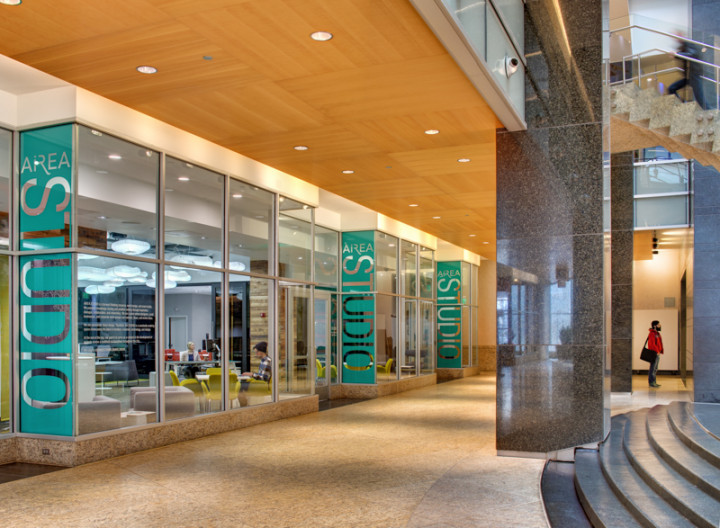
Flipping the concept of furniture dealerships on its head
Founded in 1996, AIREA Inc. has been based in suburban Farmington Hills, Mich. since its inception. A dedicated Haworth dealer (full disclosure: Haworth is the sponsor of the Work Design NOW series), a few years ago they began looking at how to match the way their clients’ businesses were evolving with an evolution of their own, and thus the idea for a satellite space was born.
“Part of the concept for the STUDIO came about because we wanted to get more exposure in the marketplace, take part in a growing Detroit, and be closer to a lot of our customers,” said Kiwior.
We’re flipping the concept of furniture dealerships on its head, and doing business with a whole new approach. It allows us to tell the story of who we are and what we do subliminally, not through direct pitch.
The STUDIO is an incubator for their own ideas and for the community’s, as well as a marketing tool to showcase their products, the types of interiors they can design, and the different types of business models that they can design for.
“People are working in different ways now,” said Kimber. “And here, we can show that.”
Early in the conceptualization process the team agreed that the STUDIO would have to be the “Swiss Army knife” of space. They set out to:
-
Showcase Haworth in a new, different, and unique way
-
Showcase new and innovative products that are ahead of the curve
-
Create a constant activity, buzz, and “ballyhoo” around AIREA’s brand
-
Host events like CEU presentations and other community gatherings
In their first year of business at the STUDIO, AIREA has had over 4,000 people visit the space and use it in some capacity: passers-by stopping in for quiet time, employees from neighboring businesses using it for meetings, or customers in for a walk-through.
“We’ve brought in around 40 customer groups, and 20 different A&D firms,” said Kiwior. “The space re-energizes them, shows them how we can leverage their own spaces a bit. It gives us something fresh to talk about.”
The ground-floor space has become a valuable amenity to the Compuware Building, too, though it wasn’t clear at first to the landlord that this would be the case.
“When we first approached Compuware, who happens to be one of our good customers, they were talking about maybe finding a space [for us] somewhere else [in the building],” said Kiwior. “We said no: we want to be here on the ground floor. They said but this is retail space—the tenants will kill us if we let a furniture dealer come in down here. They want a Taco Bell or a Starbucks, something that they can all use and take advantage of and you wouldn’t first perceive a furniture dealer to be that way.”
In terms of amenities, it’s tough to beat Taco Bell. But AIREA persisted, promising to be a good neighbor.
“And it’s been a homerun,” said Kiwior. “About half of the people who use this have an office within 100 yards of here. [Compuware brings] potential tenants down here to meet with them. We serve as a waiting room because there’s no official waiting room for the building.”
“We consciously don’t offer any kind of food service or coffee even in here because we’re trying to promote Tim Horton’s or the Hard Rock Café,” said Kiwior. “We want to promote the businesses that are here.”
And those businesses have returned the love: the Hard Rock has used the STUDIO as a green room for a band, the Thanksgiving parade used it as a VIP and media room, and it all adds up to a lot of eyes on new ways of working that wouldn’t otherwise be privy to the scene.
“Now that we’re here, we’re a part of this connected community—people know,” said Kiwior. “It’s impacted our business in so many ways from street exposure, to a more creative reputation among A&D firms, to new clients who see us here and want to [absorb some] of our creativity.”
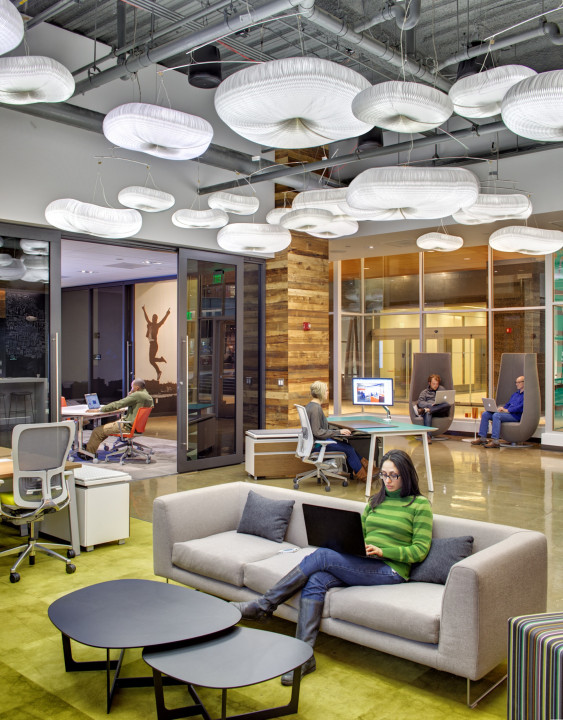
Connecting Detroit with New Ways of Working
Kid Rock—proud native son of Detroit—had a hand in the concept for the STUDIO and the larger rebranding effort AIREA Inc. He’s quoted as saying, “If it looks good, you’ll see it. If it sounds good, you’ll hear it. If it’s marketed right, you’ll buy it. But if it’s real, you’ll feel it.” That final sentence is now emblazoned on the back of every AIREA employee’s business card.
“The emotional connection to customers and people is a major part of our brand,” said Kiwior. “People walk into this space and they feel good. In the dealership world, you’ve got customers visiting four or five different dealers, they walk out of that process and they go: I know who I want to work with. I connected with somebody. It’s all these intangibles that play into that feel good.”
“We have that Kid Rock quote on our cards because we just know that is how it works,” he added.
And that attitude isn’t just extended to clients and visitors: AIREA employees feel the love, too.
“Even our marketing goes back to that emotional connection—things that make you feel good. Our proposals come off that way. The people we hire are wrapped up in this, too,” said Kiwior. “We want to help them with work/life balance. We wanted to strike the balance where it’s all right to wear jeans. We’re not quite high tops, but we’re not suits and ties. We’re somewhere in the middle.”
Detroit a startup city, whether that means a startup company or a startup individual, we depend on networking and hearing what each other are up to make things happen. This space embodies that.
“Our space was built to connect to people. Not only us to Detroit, but for Detroiters to one another,” said Bos. “Long term, we want the STUDIO to be a place where [people] come to share concepts, theories, plans, and opinions to broaden viewpoints, and become bigger visionaries. It’s about community joining forces to create stronger, more successful businesses, and a better Detroit.”
A brilliant concept, no doubt, but if people already have office space, why would they come here?
Bos pointed out that many of their visitors report a lack in meeting and conference spaces in their actual workplace, so they scoot down to AIREA for a quick chat. Kind of like a coffee shop, but with an even better vibe.
“Not a lot of offices are inspiring, so you kind of want to get out of your everyday, ho-hum [space],” said Bos. “They come down here and get re-energized. And Detroit has a huge startup community, so there are a lot of people who don’t have an office to work in yet.”
And that’s the magic of it: whether you’re a customer, an office nomad, or just Joe from the office upstairs looking for a change of scenery, there’s something to learn at AIREA. And though people are coming to AIREA to sit, the team pointed out that they’re trying to address the idea that “sitting is the new smoking”.
“This is good, comfortable, ergonomic furniture,” said Kiwior. “We’ve made, at least their sitting experience, a little better.”
“And not only that, it’s the very fact that they’re leaving one location and they’re walking down here: you’re not sitting when you’re doing that. You’re getting up and you’re moving around,” said Dr. Michael O’Neill, who leads workplace research for Haworth. “That’s the other evolving aspect of work that you’re seeing, people are working in all of these different locations. It was not too many years ago that people plopped down in their cube or office and didn’t move all day. So you’re actually adding to the health of the community by giving them a place to get up and go, take a little micro-break, even if they do sit here.”
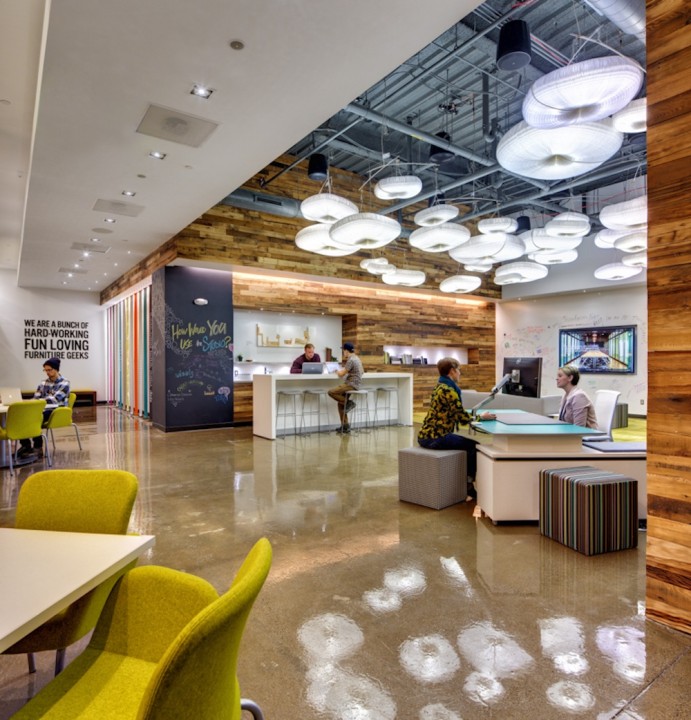
Indeed, Kiwior indicated the space was consciously programmed to be a “stop”—not a full destination.
“It fascinates me that, on one hand, it’s a furniture dealer, but it’s also an outside space that someone can use,” said Bob Fox, founder of Work Design Magazine. “For both types of users, this is a great window into some of the trends that are happening on a larger scale, and I think it’s also a great example of how spaces like this can benefit the larger workplace community.”
O’Neill agreed:
“You could sit in your basement and work and have a couple people over and do that,” he said. “Or you can come here and enjoy this really inspiring beautiful space and maybe you’ll run into others that are like you and gain some ideas and insights or some new business opportunities.”
He added that this social aspect is one half of the two broad trends driving the emergence of spaces like AIREA STUDIO. The other is economic:
“Most of the jobs that have been created since the end of the great recession have been individuals and startups. If you have a small business like that, you’re not going to want to lease traditional office space,” he said. “These spaces really fill this important role of letting people come in, have a space that they can afford, and that gives them the financial flexibility that they might need.”
Bos emphasized that the economic and social factors work hand and hand under AIREA STUDIO’s model.
“We really believe that creating and maintaining meaningful relationships through personal connection is the best way to build lasting business relationships,” she said. And because of the STUDIO, relationships are now stronger between both AIREA and their clients, and between and among AIREA and the outside users of the space.
Space, Brand, and Product Integration: A Workplace “Swiss Army Knife”
The opening of AIREA STUDIO in September 2013 coincided with a company-wide re-branding effort. The STUDIO, though, was paramount to the re-introduction of the company to the community.
“For us, the STUDIO embodies the entire essence of the future of AIREA,” said Bos. “It was really important upon our opening that our new identity was portrayed in every element of the space.”
The design had to allow for maximum flexibility in order for AIREA to inhabit its new identity. Every product in the space right now has a specific purpose and function to support flexibility. The team wanted the space to be like a “workplace Swiss Army knife.”
For permanent finishes, the team chose sources and materials that reflect AIREA’s connection to the community, including:
-
Wood from Reclaim Detroit, pulled from two abandoned homes in the city
-
Wall graphics conceived in collaboration with Detroit Wallpaper Co.
-
A completely integrated AV/IT system, along with an 80″ touchscreen, chosen and installed with the help of technology partner SVT
-
Dry-erase and glass walls on which visitors have taken to drawing their names and logos; it’s become a refection of the variety of people and businesses using the space
“We can take down the walls, and the space completely transforms,” said Bos. “All the [permanent] furniture and finishes were selected to be agile to whatever program our space needs to be: a lecture hall, speed-networking, cocktail events, professional chapter meetings, corporate ideation charrettes, teaching local college classes, meetings, individual work, movie screenings, commercial shoots, and beyond.”
“And by the way,” she added, “we’ve done all of those things.”
As you might imagine, a space like this that’s free and open to the public has got to have some rules. Right?
Well. Sort of.
When it came time to open the space, the team wondered what sorts of rules they should impose.
“I heard a speaker at a conference say that the best thing you could do with a new product is to ‘ride the horse in the direction its going’,” said Kiwior. In other words: “Let the people tell you what they want to do with it.”
Why are 100 year old buildings obsolete but 100 year old theaters are celebrated? It’s because they were built to be flexible spaces.
They had considered making a wall where they’d write rules for the space, but they scratched that idea. Instead, they’d let people “tell them” how they wanted to use it, and adjust accordingly.
“What we found really quickly was that, at lunch time, a lot of people would want to come sit in this very cool atmosphere and just eat lunch,” said Kiwior. “So we just said, ok, we’ll post hours and close at lunchtime. Now if someone comes here at two o’clock with a sandwich, it’s ok: it’s tolerable because most of the people aren’t [coming in at that time].”
But besides closing at lunch time—which also allows AIREA staff to take a break or have a lunch of their own—there are, at present, no other rules for using the space.
One way Kiwior likes to think about the space is as a “stage”, and he has spent time pondering this question: “Why are 100 year old buildings obsolete but 100 year old theaters are celebrated?”
“It’s because they were built to be flexible spaces,” he said.
For a workplace mired in less efficient strategies, the lessons to learn from AIREA are manifold.
“The message we give to people, whether it’s a client or someone off the street, is that we don’t suggest an entire office to be programmed this way. It’s not realistic and it’s not good for the psyche,” said Bos. “We advocate integrating moments like this within an open plan to break up spatial monotony. Also, these zones create the synergy needed to foster culture and camaraderie within an organization.”
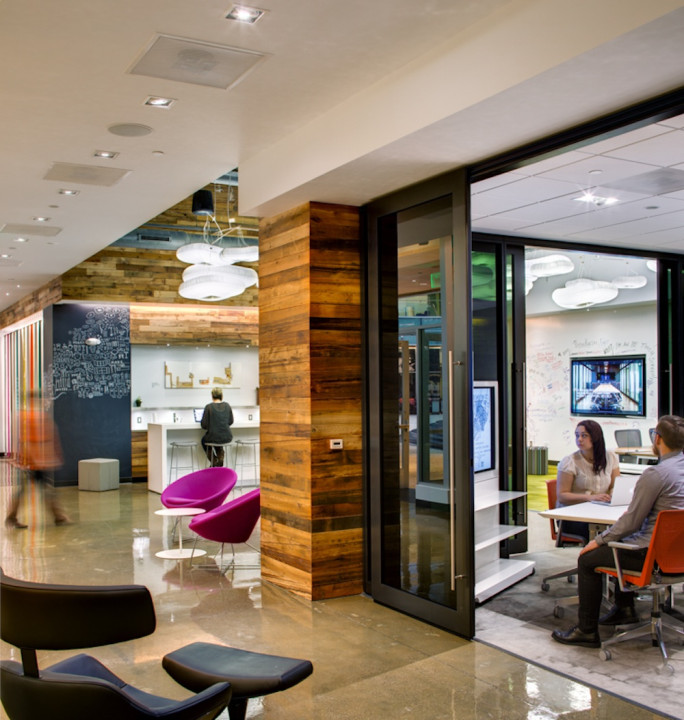
O’Neill said that this is yet another example of how the reasons we build office space have shifted.
“Not many years ago, you built office space because people had to come up to a location to do their work. Their computer was in a cubicle, fixed in place—it was a big sixty-pound box. Their phone was wired to the wall,” he said. “You had to be there to do the work. And now, people don’t have to. They’re extremely mobile.”
He added that the shift we’re seeing to creating spaces purely for functional considerations like being “a place that people want to be” is because they foster human connection.
“This space definitely has that feel,” he said. “I think it’s wonderful, because you can go to a client or an organization and talk about space, and it’s a lot of words. But they can come here and they can see that it’s possible to create a beautiful, inspiring, casual space that’s going attract people, and this is how you do it. And it’s very helpful. You’re serving a broader purpose with this space.”
The real magic is in giving people a variety of places to do their work.
He noted that the space also trades on some residential moves that “bring down the tension level and help you to connect emotionally to the space.”
“It feels authentic,” he added. “You’re not trying too hard. You’re not trying to make it something it isn’t. It’s still a place where work gets done, but it definitely has that social, emotional atmosphere to it.”
And of course, that’s the goal. More than furniture, AIREA is in the business of selling a new work experience, and the STUDIO supports that goal.
“The people who are excited about it are not here saying they want this chair or that chair; they want this feeling,” said Kiwior. “They want an environment that makes people feel how they felt walking in here. It’s the combination of every element in here is what they really want.”
Conclusion
O’Neill said that the great successes of AIREA STUDIO are in the way that they’ve built choice into the model and in the way that they’ve made the intended use of each space clear.
“You walk in to a place like this and you see: there’s a place I can be by myself, there’s benching, there’s other more social, soft seating,” he said. “The intent of these micro-areas is obvious. It creates a sense of understanding immediately when someone walks into the space, just like when you walk into somebody’s home.”
In AIREA STUDIO’s first year, the choices, the variety, and the flexibility in their model are what have drawn over 4,000 people into the space; generated numerous opportunities with new customers; bolstered their reputation as a creative company within the A&D market; and attracted more employees to AIREA Inc.
All of it has led Kiwior to the conclusion that in today’s workplace, people need a variety of spaces to do their work.
“There’s still a need for cubes and benching, but people also need four-top tables and two-top tables and one-off spaces,” he said. “You can’t take any one element and shoehorn people into it. The real magic is in giving people a variety of spaces to do their work.”
—
A special thank you to Jillian Erhardt for her graphics work on the case study PDF, and to Lost Note Productions‘ Jason Cheung for his work on the video.
Work Design NOW 2014 was sponsored by Haworth.
![]()

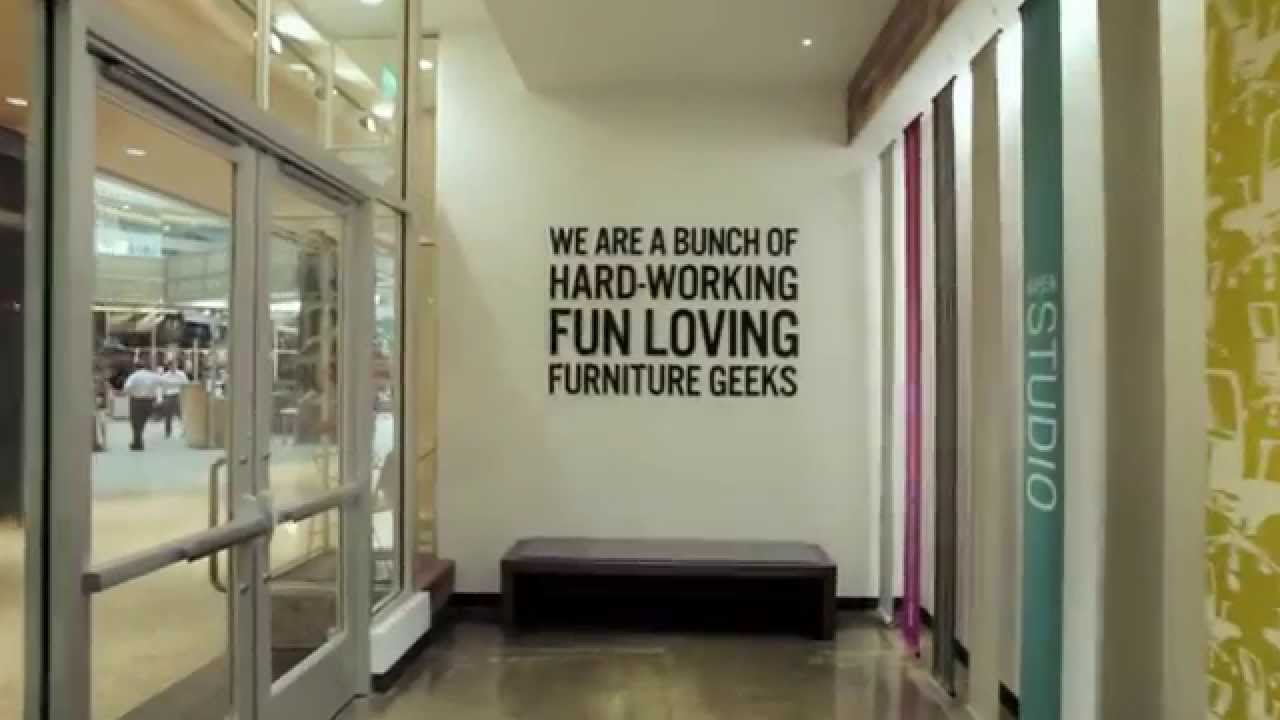

http://roshnimishra.in/east-of-kailash-escorts.html
I love this post.
Very cool!
If you are looking for how to break marriage by black magic then you are at the right place. You will get easy-to-follow techniques that will help you break any marriage.
Life is incredibly powerful to be handled alone. However Will i Get My Love Back Astrology offers you a second probability to achieve your love back once more in life.
Best article
Our Delhi high profile escorts agency provide are beautiful Russian women if you are searching top class Russian female then call here and book now.
Contact AakritiSingh for a high-class female of Delhi Escorts Services at New Delhi City. AakritiSingh is an Independent escort young lady who offering a genuine escorts service in Delhi.
Hiiiiiiiiiiiii nice post
Very nice post. I just stumbled upon your blog and wanted to say that I ave really enjoyed browsing your blog posts. After all I all be subscribing to your rss feed and I hope you write again soon!
I loved as much as you’ll receive carried out right here. The sketch is tasteful, your authored material stylish. nonetheless, you command get got an nervousness over that you wish be delivering the following. unwell unquestionably come further formerly again as exactly the same nearly a lot often inside case you shield this increase.
It’s awesome to visit this web site and reading the views of all friends about this post, while I am also keen of getting familiarity.
Visit Now ;- https://electroniccityescorts.blogspot.com/
best here =-= http://renurana.in/connaught-place-escorts.html
hiiiince so meet here contact
My brother recommended Thank you!
msreeya
We are the best SEO Company In India having more than 10 years of experience in this field.
visit our website https://www.indeedseo.com for all kind of information about SEO And ORM.
Well Thanks For Posting Such An Outstanding Idea. I Like This Blog & I Like The Topic And Thinking Of Making It Right.
Istikhara Online UK London Centre wazifa for depression. wazifa for job success, Wazifa for love marriage, wazifa for driving test, 100% privacy Call me Today i’m living India. Rohani Ilaj and wazifa for all problems, London Centre The best Email service 100% privacy.
Thank you for excellent article.You made an article that is interesting.
Please refer below if you are looking for best tour and travels in chennai
http://saravanatravels.in/vehicle-tariff/innova-car-for-rent-in-chennai/
We offer the best online assignment help and academic writing service in AUS, UK & USA. Hire native experts now & get FLAT 20% OFF on your first order.
With the amazing cost students can get their marketing assignment help searvice and easily collect our more best services from the professional experts of StudentsAssignmentHelp.com. Students who are demanding for homework for them we are continue giving best team and they can easily complete all your work. So, you can collect top homework service easily.
yes! it is so nice , we can do it!
lets go !
ok ~ we can do it ! we have the good equirtment
yes ! l will do it ! you can say we should like you!
we can do it , l think we can eat much!
yes, l like this ! can you tell me whats you say?
ok! we will have so much money!
yes , l like you!
you are welcome!
ok! we can email you! can you give me a choice!
l like you!
High Profile Delhi Escort Services at 25% Discount 9873940964
very nics
The article is well written and structured! Great Job! Have a look at my work – Your Love Tarot Card Reading.
Hey Can you provide me details of this Studio. Thanks I am waiting.
Hey Can you provide me details of this Studio. Thanks I am waiting. By the way If anyone needs Logo Design Service visit Logo Design Services in Australia.
Thanks for sharing such a nice Blog.I like it.
I am sure that it will be very useful for me and for other people. Please continue to post such content.
I’m waiting for your next post.
Fantastic post, very much useful information. I found your blog a few days ago from Google and have been reading it over the past few days.
how are you baby
we are provide best service:——
The case study is the best things to analysis ourself to do better and better.
the case study is the best part to analysis and grows yourself to do more best.
Thank you for posting such a great article! I found your website perfect for my needs. It contains wonderful and helpful posts. Keep up the good work!. Thank you for this wonderful Article!
Hiiiiiiiiiiii nice post
I am very impressed with your article. I love the way you write this article. Thank you for sharing this wonderful post with us.
hiiiiii hellooooo nice too meet :—– http://www.gfingoa.com/
Thank you and your article. They are really good and useful. I hope to have similar articles. Here is my website, give me your comments. Cải Thiện Sức Khỏe Tâm Lý
Thank you and your article. They are really good and useful. I hope to have similar articles. Here is my website, give me your comments. http://tamlysuckhoe.com/tinh-yeu-va-hon-nhan/
It’s good to have read this information from you. They really help me. You can visit my website and give me contributions. http://suckhoetrongtay.com/suc-khoe-az/xo-cung-bi/
welcome to
hi
Pretty nice post. I simply stumbled upon your blog and wished to say that I have really loved surfing around your weblog posts.
Awesome article! It is in detail and well formatted that i enjoyed reading. which in turn helped me to get new information from your blog.
I have been checking out many of your posts and it’s nice stuff. I will definitely bookmark your website.
Hey! This is my first comment here so I just wanted to give a quick shout out and tell you I genuinely enjoy reading your posts. Can you recommend any other blogs/websites/forums that go over the same subjects? Thanks for your time!
Our exclusive Dehradun escorts are not only beautiful but honest, proud and have integrity and always place the discretion of themselves of their clients as paramount.
all kind information visit here
hellooooooooo ============ http://manishasharma.in/
Very Informative article a lot of quality content to read. Thanks for sharing this with us. Good to hear from you again.
Thamks!
chemical importers in india
Hope you will keep on offering good content like this more often. I feel more and more people should know about this. Also, I agree on most of the points you have made.
lancerguru
I constantly spent my half an hour to read this website’s articles all the time along with a cup of coffee.
Are grateful for this blog post, it’s tough to find good information and facts on the internet
Good information. Lucky me I found your site by chance I’ve bookmarked it for later!